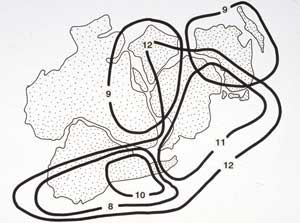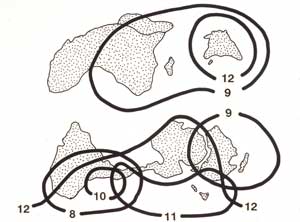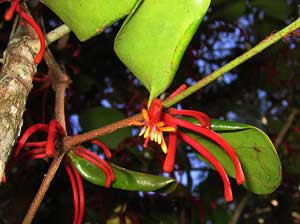Mistletoes - biogeography
Loranths of the intrusive element
How do we account for the remaining Australian loranths? These fall into two groups, but they appear to have a common geographic pattern. One group comprises the 12-chromosome genera Decaisnina ![]() , Amylotheca
, Amylotheca ![]() and Lysiana
and Lysiana ![]() . Their 12-chromosome relatives are tropical genera with their centre of concentration in southeast Asia. Indeed most species of Decaisnina occur in Indonesia and the Philippines, and Amylotheca is also represented in Thailand and western Indonesia.
. Their 12-chromosome relatives are tropical genera with their centre of concentration in southeast Asia. Indeed most species of Decaisnina occur in Indonesia and the Philippines, and Amylotheca is also represented in Thailand and western Indonesia.
|
Genus |
Chromosome |
Number |
Distribution |
Intrusive |
||||
Indogondwanan |
Macrosolen |
12 |
30 |
India to New Guinea |
Lepeostegeres |
12 |
9 |
Malaya to New Guinea |
|
Decaisnina |
12 |
25 |
Philippines - Australia |
|
Cyne |
|
6 |
Philippines - N Guinea |
|
Amylotheca |
12 |
38 |
S Asia to Australia |
|
(young endemics) |
Lysiana |
12 |
8 |
Australia |
Benthamina |
9 |
1 |
Australia |
|
The other group comprises the genera with 9 chromosomes, somewhat smaller than those of the Amyema species group. Dendrophthoe ![]() is also an Asian genus, with a few species reaching Australia or endemic there. Benthamina, although a local endemic in eastern Australia, is clearly related to other Asian genera in the Dendrophthoe alliance.
is also an Asian genus, with a few species reaching Australia or endemic there. Benthamina, although a local endemic in eastern Australia, is clearly related to other Asian genera in the Dendrophthoe alliance.
It therefore appears that these mistletoe genera in the Australian region have had a different history from the original Gondwanan stocks. They are more recent arrivals, having crossed Wallace’s Line from the northwest after contact between the Australian and Indonesian plates. They have diversified to some extent in their new homeland, but are still predominantly species of tropical or monsoon habitats. Lysiana is the most specialized of the 12-chromosome loranths; it is presumably a young genus which has differentiated in Australia, but even in Lysiana most of its species are tropical. Benthamina is apparently an outlier of a group of genera which otherwise now only reaches the Lesser Sunda Islands.
Given the apparent Gondwanan origin of Loranthaceae, how do we explain the intrusion of loranths into Australia from the north? The likely explanation involves the geophysical history of India and parts of southeast Asia as Gondwanan fragments. During the time India was rafting northwards towards collision with Asia in the middle Eocene, its climates may have been continuously equable. India may therefore have carried a differentiated flora of Gondwanan origin to Asia at the same time as another subset was differentiating on the Australian fragment (below, numbers indicate chromosome number). This Indian/Asian subset of Loranthaceae appears to be the source of all African loranths, as well as the intrusives which have reached Australia, there meeting up with Gondwanan relatives they sailed away from tens of millions of years earlier.
 |
 |
![An Australian Government Initiative [logo]](/images/austgovt_brown_90px.gif)


